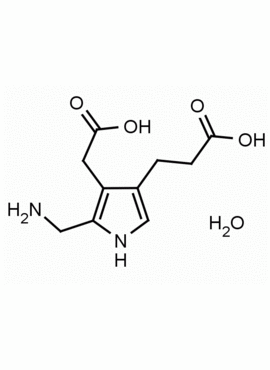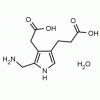CAS: 487-90-1 MDL: MFCD00005224
Sizes Available: 5 mg, 10 mg, 100 mg, and larger sizes available
Molecular weight: 226.229 g/mol
Molecular Formula: C10H14N2O4
CAS Number: 487-90-1
Storage: Store at –20 °C, under Argon
Synonyms: CHEBI:17381, CHEMBL1235151, Porphobilinogen 5-(Aminomethyl)-4-(carboxymethyl)-1H-pyrrole-3-propanoic acid
Field of Interest: Natural Products Synthesis, Heme Containing Proteins, Hemoglobin, Myoglobin, Cytochrome C pathology, Complexes, Chlorophyll Biosynthesis
Background: Porphobilinogen is a pyrrole based natural product that is a starting material for the biosynthesis of porphyrins such as heme and chlorophyll. 1,2 It also is a main indicator of altered metabolism where porphobilinogen is indicative of lead poisoning and a biomarker and indicator of porphyria disease. 3,4
References:
1.) Winslow S. Caughey, James A. Ibers, Crystal and Molecular Structure of the Free Base Porphyrin, Protoporphyrin IX Dimethyl Ester, J. Am. Chem. Soc. 99: 1977, 6639–6645.
2.) R. Battersby; C. J. R. Fookes; G. W. J. Matcham; E. McDonald, Biosynthesis of the pigments of life: formation of the macrocycle, Nature. 285: 1980, 17–21.
3.) Jaffe, Eileen K.; Martins, Jacob; Li, Jian; Kervinen, Jukka; Dunbrack, Roland L., Jr., The molecular mechanism of lead inhibition of human porphobilinogen synthase, Journal of Biological Chemistry (2001), 276(2), 1531-1537. .
4.) Kauppinen, R.; Mustajoki, S.; Pihlaja, H.; Peltonen, L.; Mustajoki, P., Acute intermittent porphyria in Finland: 19 mutations in the porphobilinogen deaminase gene, Human Molecular Genetics (1995), 4(2), 215-22..

